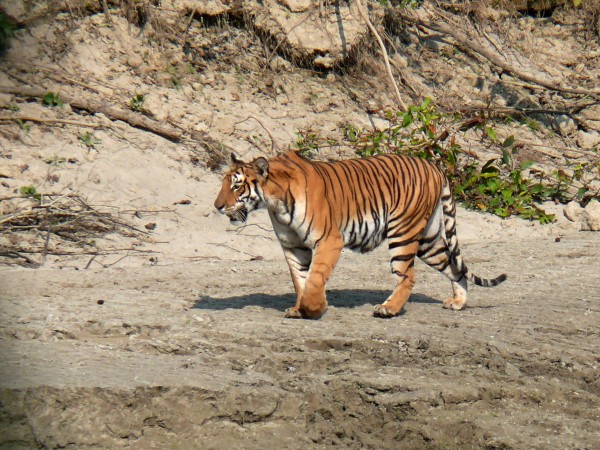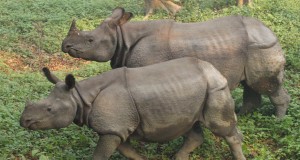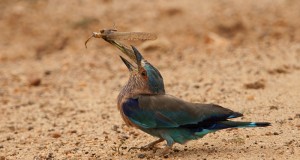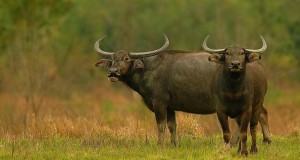About 250 miles (400 km) to the west of Khatmandu, in far western Nepal, l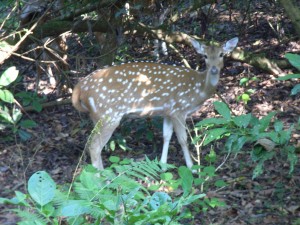 ies the Royal Bardia Wildlife Reserve, also known as Karnali because of the great river of that name that drains the region. Initially set aside as a royal hunting preserve during the Rana regime (1846-1950), it was declared a wildlife reserve in 1976 with an area of 134 sq miles (348 sq km), increased in 1985 to 374 sq miles (968 sq km).TV reserve is bounded to the west by the Karnali river and its distributary, the Girwa, and to the east by a section of the Nepalgunj- Birendranagar highway. A large part of the reserve is hill country as it drapes the southern flanks of the Churia or Siwalik hills, the outermost range of the Himalaya. The crestlines of the Churia form its northern boundary.
ies the Royal Bardia Wildlife Reserve, also known as Karnali because of the great river of that name that drains the region. Initially set aside as a royal hunting preserve during the Rana regime (1846-1950), it was declared a wildlife reserve in 1976 with an area of 134 sq miles (348 sq km), increased in 1985 to 374 sq miles (968 sq km).TV reserve is bounded to the west by the Karnali river and its distributary, the Girwa, and to the east by a section of the Nepalgunj- Birendranagar highway. A large part of the reserve is hill country as it drapes the southern flanks of the Churia or Siwalik hills, the outermost range of the Himalaya. The crestlines of the Churia form its northern boundary.
From the base of the Churia the ground slopes gradually southward for about five miles (eight km), and this highly porous ground is called the bhabhar. Thereafter, it flattens out as far as the eye can see. This is part of the Gangetic plain, and the strip between the Bhabhar and the Indian border is known as the terai. The southern edge of the reserve is mainly bhabhar, with a small piece of feral at the southwest.
Flora and Fauna: Bardia, with its stately sal (Shorea robusta) trees, its tall termite mounds, its patches of grassland, locally known as phanias, is very reminiscent of Dudhwa in Uttar Pradesh. The forests are tropical dry deciduous. Since a great part of the park is high ground with good drainage, it is dominated by the sal, a hardwood tree. The sal associates with many other trees, notably saj or asna (Termina ha totnentosa), and on the highest ridges of the hills, with char pine ( Pinus roxhurghii ). The sal forest and its shaded ravines are the home of samba , barking deer, porcupine, sloth bear and kaleej.
On the lower ground is a mosaic of grassland and riverine forest with the simal trees (Bombax Ceiba) standing above all others. The simal when old are gigantic in size and develop huge buttresses at their base for extra support and their large red, sometimes orange, flowers are a memorable sight in the early spring. The phanias are old village sites where a small herd of barasingha ( Cervus duvauceli) and blackbuck ( Antilope cervicapra) may still b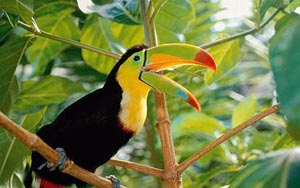 e seen.The waters of the Karnali emerge from the narrow gorge at Chisapani, fan out over a gentle slope and eventually slow down to a sluggish pace on the plains. A couple of miles downriver of the gorge it branches out • into two main channels or distributaries — Karnali to the west and Girwa to the east — which enclose large and small islands of sand and gravel. Here shisham ( Dalbergia sissoo), khair (Acacia catechu) and simal flourish (such an assortment of trees is common on all riverine sites). These islands are the favorite haunts of the ungainly nilgai, the subcontinent’s largest antelope. But much of the park is drained by another smaller river, the Babai, which courses down the Siwalik range and collects spring and rain water from its numerous seasonal and perennial tributaries. The Karnali-Girwa and the Babai attract a large number of migratory waterfowl.
e seen.The waters of the Karnali emerge from the narrow gorge at Chisapani, fan out over a gentle slope and eventually slow down to a sluggish pace on the plains. A couple of miles downriver of the gorge it branches out • into two main channels or distributaries — Karnali to the west and Girwa to the east — which enclose large and small islands of sand and gravel. Here shisham ( Dalbergia sissoo), khair (Acacia catechu) and simal flourish (such an assortment of trees is common on all riverine sites). These islands are the favorite haunts of the ungainly nilgai, the subcontinent’s largest antelope. But much of the park is drained by another smaller river, the Babai, which courses down the Siwalik range and collects spring and rain water from its numerous seasonal and perennial tributaries. The Karnali-Girwa and the Babai attract a large number of migratory waterfowl.
Wildlife Viewing: The best place for this is the old reserve area between the Karnali- Girwa and the Babai rivers, especially along the former, and the adjoining phantas such as Baghora and Lamkoili.
At present, only one private facility for tourists exists in Bardia. A couple of miles to the south of Chisapani (west) on the east bank of the Karnali-Girwa, is the Karnali Tented Camp which runs landrover, raft and walking safaris. It also runs fishing expeditions for the mighty mahseer. You need four-five nights to fully appreciate the jungle and its sights in Bardia. A trip there is a mixture of wildlife, culture and adventure. All, even any one, of the following day-trips will confirm this.
Rafting Down the firwa: Start by rubber raft from Karnali Camp around 9 a.m. and float down the Girwa river. A couple of hours later, stop at a strand downriver for lunch. W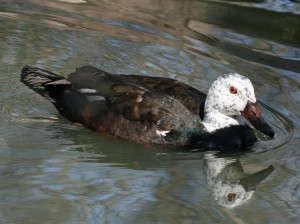 hile food is being cooked, you may watch birds, study tracks on the riverbank or just relax in the sun. After lunch, resume your journey and raft down to Mann Tappu Ghat. On this river trip you will see many species of birds — duck, heron, gull, tern, kingfisher, cormorant and osprey; and perhaps also rhesus monkey ( Macaca mulatto), langur (Presbyters enrellus), nilgai (Boselephus tragocamelus) and otter (Luira perspicillat a). If you are lucky, you may even glimpse the Gangetic dolphin as it surfaces for air; Manu Tappu is a particularly good place for this. On your drive back to camp, via the phantas, you will add more animals to your spotting list, such as chital and wild boar.
hile food is being cooked, you may watch birds, study tracks on the riverbank or just relax in the sun. After lunch, resume your journey and raft down to Mann Tappu Ghat. On this river trip you will see many species of birds — duck, heron, gull, tern, kingfisher, cormorant and osprey; and perhaps also rhesus monkey ( Macaca mulatto), langur (Presbyters enrellus), nilgai (Boselephus tragocamelus) and otter (Luira perspicillat a). If you are lucky, you may even glimpse the Gangetic dolphin as it surfaces for air; Manu Tappu is a particularly good place for this. On your drive back to camp, via the phantas, you will add more animals to your spotting list, such as chital and wild boar.
Trek Out and Float Back: Take an early morning walk up to Chisapani gorge, birding as you go. Cross the river by ferry or by raft, then follow the old trading route that runs along the west bank of the Karnali. The road has been cut out of stone into a steep hillside and is well worn by centuries of use by traders and their pack animals. You will meet traders from Dailekh and Aehham to the north, heading for Chisapani with their produce and then returning home with salt, kerosene and other goods. These are hardy men and women, with even hardier beasts of burden, mainly goat and sheep, each laden with 25 lb (55 kg) load on its back. The hillside is forested and during the mid-morning, bird-watching conditions are excellent.
After about 2 1/2 hours of walking, you descend to the riverbank for lunch just short of the small village of Kachalipur. Rafting back through the gorge, you will be struck by the peculiar rock formations along the banks which provide excellent hideouts for otters, and good vantage points for crocodiles to bask in the sun.
Gray and crimson wall creepers (Tichodroma muraria), common winter birds in the gorge, fly about on the vertical cliffs, and here and there white droppings of co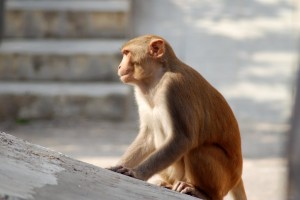 rmorant and darter decorate the black rock. As you come out of the gorge, a spectacular view of the floodplains opens up in front of you. Drive and Walk: Drive southeast (with packed lunch), for about eight miles (13 km) and near Amreni turn northwards towards the base of the hills. The forest here becomes dense and dark, giant creepers drape the sal trees and the “tentacles” of the strangler figs literally squeeze the life out of their hosts. You may see evidence of the passage of wild elephant—droppings, tracks, uprooted trees, and trees stripped of their bark. Carry on to Danawa Tal guard post and trek into the hills for a couple of hours. On the stream beds look for the tracks of the animals that have passed here — tiger, leopard, monkey, porcupine, civet and others.
rmorant and darter decorate the black rock. As you come out of the gorge, a spectacular view of the floodplains opens up in front of you. Drive and Walk: Drive southeast (with packed lunch), for about eight miles (13 km) and near Amreni turn northwards towards the base of the hills. The forest here becomes dense and dark, giant creepers drape the sal trees and the “tentacles” of the strangler figs literally squeeze the life out of their hosts. You may see evidence of the passage of wild elephant—droppings, tracks, uprooted trees, and trees stripped of their bark. Carry on to Danawa Tal guard post and trek into the hills for a couple of hours. On the stream beds look for the tracks of the animals that have passed here — tiger, leopard, monkey, porcupine, civet and others.
Stop by a pool for a picnic lunch and then drive back to the base of the hills and take the road to the Babai river. Peafowl and red jungle fowl are common here and you may also see gharial or mugger crocodiles. On your return drive, visit the phantas again. Towards late afternoon, the jungle comes alive with the activity of its denizens and you may spot blackbuck, barasingha and wild hoar, not to mention the abundant chital. Spotter’s Luck: But what you see, and how much, depends on chance, and in any of these three outings you could well seeleopard, sloth bear and wild elephant. If the rhinos introduced here in early 1986 flourish, they are then likely to become Bardia’s star attraction. Predators of Bardia also include hyena, wild dog, jackal, the large and the small Indian civet, mongoose, python, mugger and gharial. The tall grass also harbors some hispid hare, believed, until recently, to have become extinct. Over 350 species of birds have been recorded.
The tourist season here is from November through May; for the rest of 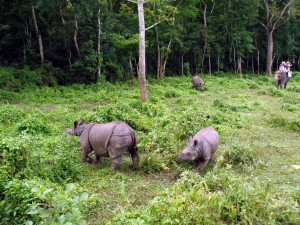 the year the reserve is inaccessible because of the monsoon floods. The weather is generally warm, but gets cold in the early morning and evening in December and January. During these two months, each year, local villagers are allowed to enter the park for a couple of weeks to collect thatch grass and reed to use as building materials for their houses. Having collected their harvest, the villagers set fire to the grassland and forest, and much of the undergrowth is burnt to ashes. But regrowth is quick and numerous herbivores congregate on the now open phansas to feed on the new succulent grasses. Thus the best wildlife sightings in Bardia are between January and April when the vegetation is “open” and visibility better than at other times.
the year the reserve is inaccessible because of the monsoon floods. The weather is generally warm, but gets cold in the early morning and evening in December and January. During these two months, each year, local villagers are allowed to enter the park for a couple of weeks to collect thatch grass and reed to use as building materials for their houses. Having collected their harvest, the villagers set fire to the grassland and forest, and much of the undergrowth is burnt to ashes. But regrowth is quick and numerous herbivores congregate on the now open phansas to feed on the new succulent grasses. Thus the best wildlife sightings in Bardia are between January and April when the vegetation is “open” and visibility better than at other times.

